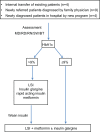Design, implementation, and evaluation of a pediatric and adolescent type 2 diabetes management program at a tertiary pediatric center
- PMID: 25114539
- PMCID: PMC4124128
- DOI: 10.2147/JMDH.S63842
Design, implementation, and evaluation of a pediatric and adolescent type 2 diabetes management program at a tertiary pediatric center
Abstract
Global rates of type 2 diabetes in children and adolescents have increased significantly over the past three decades. Type 2 diabetes is a relatively new disease in this age group, and there is a dearth of information about how to structure treatment programs to manage its comorbidities and complications. In this paper, we describe the design and implementation of a personalized multidisciplinary, family-centered, pediatric and adolescent type 2 diabetes program at a tertiary pediatric center in Hamilton, Ontario, Canada. We report the process of designing and implementing such a program, and show that this multidisciplinary program led to improvement in glycated hemoglobin (n=17, 8% at baseline versus 6.4% at 1 year, 95% confidence interval (0.1-0.28), P-value <0.0001) and stabilized body mass index, with lowered C-peptide and no change in fitness or metabolic biomarkers of lipid metabolism and liver function. As type 2 diabetes becomes more prevalent in youth, the need for programs that successfully address the complex nature of this disease is central to its management and to mitigate its long-term adverse outcomes.
Keywords: adolescents; multidisciplinary; pediatric; program design; type 2 diabetes.
Figures




Similar articles
-
Community-based care for the specialized management of heart failure: an evidence-based analysis.Ont Health Technol Assess Ser. 2009;9(17):1-42. Epub 2009 Nov 1. Ont Health Technol Assess Ser. 2009. PMID: 23074521 Free PMC article.
-
Structured, intensive education maximising engagement, motivation and long-term change for children and young people with diabetes: a cluster randomised controlled trial with integral process and economic evaluation - the CASCADE study.Health Technol Assess. 2014 Mar;18(20):1-202. doi: 10.3310/hta18200. Health Technol Assess. 2014. PMID: 24690402 Free PMC article. Clinical Trial.
-
Testing an audit and feedback-based intervention to improve glycemic control after transfer to adult diabetes care: protocol for a quasi-experimental pre-post design with a control group.BMC Health Serv Res. 2019 Nov 25;19(1):885. doi: 10.1186/s12913-019-4690-0. BMC Health Serv Res. 2019. PMID: 31766999 Free PMC article. Clinical Trial.
-
Psychological interventions to improve self-management of type 1 and type 2 diabetes: a systematic review.Health Technol Assess. 2020 Jun;24(28):1-232. doi: 10.3310/hta24280. Health Technol Assess. 2020. PMID: 32568666 Free PMC article.
-
Weight management services for an underserved population: a rapid review of the literature.Disabil Rehabil. 2020 Jan;42(2):274-282. doi: 10.1080/09638288.2018.1497713. Epub 2018 Oct 9. Disabil Rehabil. 2020. PMID: 30298750 Review.
Cited by
-
Integration of chronic disease prevention and management services into primary care: a pragmatic randomized controlled trial (PR1MaC).CMAJ Open. 2016 Oct 12;4(4):E588-E598. doi: 10.9778/cmajo.20160031. eCollection 2016 Oct-Dec. CMAJ Open. 2016. PMID: 28018871 Free PMC article.
-
Appraisal of clinical practice guidelines for management of paediatric type 2 diabetes mellitus using the AGREE II instrument: a systematic review protocol.Syst Rev. 2016 Jul 13;5(1):111. doi: 10.1186/s13643-016-0288-3. Syst Rev. 2016. PMID: 27412255 Free PMC article.
-
The Effectiveness of Indigenous Knowledge-Based Lifestyle Interventions in Preventing Obesity and Type 2 Diabetes Mellitus in Indigenous Children in Canada: A Systematic Review.Adolesc Health Med Ther. 2023 Sep 28;14:175-193. doi: 10.2147/AHMT.S405814. eCollection 2023. Adolesc Health Med Ther. 2023. PMID: 37790916 Free PMC article. Review.
-
Translating knowledge into action to prevent pediatric and adolescent diabesity: a meeting report.Adolesc Health Med Ther. 2019 Aug 26;10:91-101. doi: 10.2147/AHMT.S209922. eCollection 2019. Adolesc Health Med Ther. 2019. PMID: 31692573 Free PMC article.
-
Developing and Evaluating Behaviour Change Interventions for People with Younger-Onset Type 2 Diabetes: Lessons and Recommendations from Existing Programmes.Curr Diab Rep. 2021 Dec 13;21(12):59. doi: 10.1007/s11892-021-01432-1. Curr Diab Rep. 2021. PMID: 34902067 Review.
References
-
- Whiting DR, Guariguala L, Weil C, Shaw J. IDF diabetes atlas: global estimates of the prevalence of diabetes for 2011 and 2030. Diabetes Res Clin Pract. 2011;94(3):311–321. - PubMed
-
- Pinhas-Hamiel O, Zeitler P. The global spread of type 2 diabetes mellitus in children and adolescents. J Pediatr. 2005;146(5):693–700. - PubMed
-
- Rosenbloom AL, Joe JR, Young RS, Winter WE. Emerging epidemic of type 2 diabetes in youth. Diabetes Care. 1999;22(2):345–354. - PubMed
LinkOut - more resources
Full Text Sources
Other Literature Sources
Research Materials
Miscellaneous

